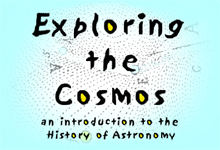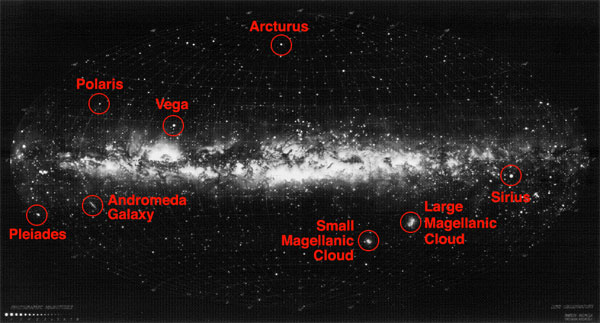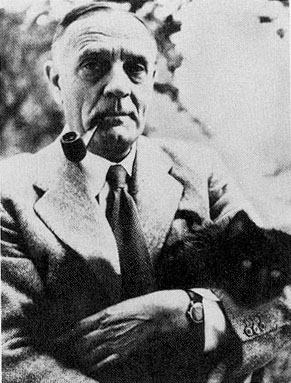

Department of History
University of California, Irvine
Instructor: Dr. Barbara J. Becker
![]()
Lecture 17. Discovering the Milky Way.
![]()
Today's city-dwellers are surrounded by lights bright enough to drown out the hazy celestial film known as the Milky Way. It is hard for them to appreciate what a perplexing problem observers in the past were faced with when they tried to understand the source of the faint glow that arched like a giant luminous spine across the sky. What is the Milky Way? What can it tell us about the structure of the universe and our place in it?

Map of the Milky Way in galactic coordinates created in 1955 by Martin and Tatjana Kesküla under the direction of Swedish astronomer, Knut Lundmark (1889-1958). Using photographs as a reference, the Keskülas carefully plotted the images of 7,000 stars by hand. They then painted in the nebulous regions to produce an almost photographic effect. I have added the superposed annotations to help identify a few familiar sky objects.
The Milky Way |
What was observed by us in the third place is the nature or matter of the Milky Way itself, which, with the aid of the spyglass, may be observed so well that all the disputes that for so many generations have vexed philosophers are destroyed by visible crertainty, and we are liberated from wordy arguments. For the Galaxy is nothing else than a congeries of innumerable stars distributed in clusters. To whatever region of it you direct your spyglass, an immense number of stars immediately offer themselves to view, of which very many appear rather large and very conspicuous but the multitude of small ones is truly unfathomable. And since that milky luster, like whitish clouds, is seen not only in the Milky Way, but dispersed through the ether, many similarly colored patches shine weakly; if you direct a glass to any of them, you will meet with a dense crowd of stars. Moreover -- and what is even more remarkable -- the stars that have been called "nebulous" by every single astronomer up to this day are swarms of small stars placed exceedingly close together. While each individual one escapes our sight because of its smallness or its very great distance from us, from the commingling of their rays arises that brightness ascribed up to now to a denser part of the heavens capable of reflecting the rays of the stars or Sun. |
|
The Milky Way described by William Herschel in "On the Construction of the Heavens" (1785) |
I shall now proceed to shew that the stupendous sidereal system we inhabit, this extensive stratum and its secondary branch, consisting of many millions of stars, is, in all probability, a detached Nebula.... [I]t is ... to be hoped that in some future time this branch of astronomy will become more cultivated, so that we may have gages for every quarter of a degree of the heavens at least, and these often repeated in the most favourable circumstances.... I look upon what is here given partly as only an example to illustrate the spirit of the method.
"A very extensive, branching, compound Congeries of many millions of stars..." From this figure however, which I hope is not a very inaccurate one, we may see that our nebula, as we observed before, is of the third form; that is: A very extensive, branching, compound Congeries of many millions of stars; which most probably owes its origin to many remarkably large as well as pretty closely scattered small stars, that may have drawn together the rest.... |
Spiral Nebulae: Vast Stellar Systems, or Massive Swirls of Planet-forming Matter |
||
| In November 1888 -- a century after Herschel situated the Sun and its system of planets in the midst of a "compound Congeries of many millions of stars" -- Isaac Roberts (1829-1904) sent a copy of a photograph
he had taken of a nebula to William Huggins.
Huggins described the photo in a letter (November 27, 1888) to the Secretary of the Royal Society, George Gabriel Stokes:
A week later, William's wife, Margaret made the following entry in their observatory notebook:
The Hugginses were not the only ones captivated by the engimatic spiral nebulae. |
| In 1900, Cornelius Easton (1864-1929) suggested that the spirals might
serve as a model for our own Milky Way star system. He envisioned
the Milky Way as a spiral with the Sun a bit displaced from the center.
The Milky Way star system, by Cornelius Easton (1900) For some astronomers, the spirals and other fuzzy little objects were new planetary systems in formation. For others, they exemplifed what a complex star system like our own Milky Way might look like if we could see it from a great distance. It wasn't easy to decide which view was correct because solid observational evidence seemed to lend support to both models. |
In 1915, Harlow Shapley (1885-1972) used cepheid variables contained in globular clusters to estimate the distance to each cluster. There are an estimated 150 globular clusters that swarm around our galaxy. Each of them contains 100,000 to 1,000,000 stars in a spherical region only a few hundred light-years in diameter.
M13 is a globular cluster in the constellation Hercules. Astronomers today estimate it to be located about 7200 pc away from us. M13, pictured above, looks larger to us than most other globular clusters. In fact, individual stars in the cluster can be observed, including some cepheid variables. It's not surprising, then, that Shapley picked it as one of his first targets of study. After observing several cepheids in the cluster, he concluded that M13 is about 30,000 pc away from us -- an enormous distance, far greater than anything astronomers had ever measured. Could these distant star systems be comparable in size to our own Milky Way? Similar observations of cepheids in other globular clusters convinced Shapley that they are all located at tremendous distances from us. But plotting their distribution in space revealed another curious puzzle -- globular clusters are distributed asymmetrically around us.
Earth's position is noted by the "x" on Shapley's plot of the distribution of globular clusters.
The yellow star in the illustration above symbolizes our position; the light blue region surrounding the star symbolizes the array of stars we can see; the small blue dots symbolize the swarm of globular clusters in our system. Shapley concluded that we Earthlings are limited in the stars we can see. This has tricked us into assuming (mistakenly) that we are at the center of everything. But the distribution of globular clusters demonstrates that our star system is much bigger than we had imagined, and we are located, not at its center, but near its edge. |
Discovering the Galaxy |
|
Meanwhile, in 1916, Adriaan van Maanen (1884-1946) announced he had obtained incontrovertible photographic proof of rotation in face-on spiral nebulae. Van Maanen's claim encouraged those who believed the spirals were small, nearby planetary systems, including Harlow Shapley, who wrote to van Maanen: Congratulations on the nebulous results! Between us we have put a crimp in the island universes, it seems, -- you by bringing the spirals in and I by pushing the Galaxy out. We are indeed clever, we are. 
Adriaan van Maanen's measures showing rotation in the spiral nebula, M33. But, in 1917, George Ritchey (1864-1945) photographed a nova in another face-on spiral nebula, NGC 6946. A nova signals the presence of at least one star. Clearly NGC 6946 is more than just a glowing cloud of gas and dust. In fact, Ritchey's observation lent solid support behind the view that spirals are likely quite large and distant objects. By 1918, there were two principal models for the structure of the universe:
|
|
Island Universe Model
chief proponent: Jacobus Kapteyn |
In the illustration, the yellow star symbolizes our position; the light blue area symbolizes the Milky Way composed of all the individual stars we can see; the blue ovals symbolize other large collections of stars, each one having a size similar to our own Milky Way. |
Milky Way = Universe Model
chief proponent: Harlow Shapley |
The yellow star symbolizes our position; the light blue area symbolizes all the individual stars in the Milky Way/universe, some which we can see from our vantage point (those in the shaded area around the yellow star) while the rest are obscured from our view; the blue dots symbolize the globular clusters that swarm around the Milky Way; the blue ovals symbolize other solar systems in formation. |
The Great Debate |
||||||||||||
| In 1920, Harlow Shapley presented the case for his model at a meeting
of the National Academy of Sciences.
Astronomer Heber Curtis argued for Kapteyn's "Island Universe" model.
|
||||||||||||
| In 1923 Edwin Hubble (1899-1953) used the new 100-inch telescope at
the Mt. Wilson observatory to photograph M31. For the first time
ever, individual stars could be distinguished on the photographic plate!
Hubble continued to photograph M31 and searched among its many stars for
signs of novae.
Hubble's observatory notebook observations showing
the changes in brightness of a star in M31 which he believed to be a nova.
On October 6, 1923, Hubble scratched out the "N" (for nova) next to the cepheid on the photographic plate and wrote "VAR!" (for variable). Hubble's discovery of a cepheid variable in M31 made it possible to apply Henrietta Leavitt's period-luminosity method and determine that M31 is located at the remarkable distance of 1 million light-years (300,000 parsecs)! In 1924, Knut Lundmark announced he had failed to confirm Van Maanen's observations showing rotation in the spiral galaxy M33.
Lundmark's examination of 400 luminous points in M33 produced no evidence the spiral nebula is rotating. For most astronomers, Hubble's research on M31 resolved the mystery of the spirals. Of course, it raised a whole new set of questions:

Edwin Hubble and Copernicus (the cat) |
|